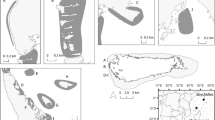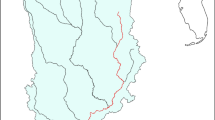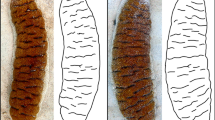Abstract
The scale and patterns of movement and habitat use are primary considerations in the conservation and management of threatened species. Movement, activity and habitat use of the threatened two-spined blackfish Gadopsis bispinosus were assessed in a small upland reservoir in south-eastern Australia using manual and remote radio-telemetry. Movements and activity of two-spined blackfish (n = 19) were studied over a 28-day period and exhibited proportionately large directional crepuscular movement and activity with heightened activity continuing throughout the night (although movement was subdued). Two daily movement strategies were observed: movements from diurnal home-shelter habitats (predominantly rock) to macrophytes at night (14 individuals), and occupation of macrophytes during the entire diel period and restricted movement (five individuals). Daily movement strategies were fixed (not plastic) among all individuals, with one exception, for the duration of the study period. Rock, fallen timber and macrophytes were the most commonly used daytime shelter habitat (in order of preference). Although some information exists on movements and habitat use of this species and the congeneric river blackfish G. Marmoratus in lotic environments, we present the first study of movements and habitat use for either species in lentic environments. Given the occupation of lentic environments by this threatened species, the data presented in this study provide insight into the habitat requirements for this species, and offer opportunities for habitat enhancement in existing reservoirs within the species’ geographic range.




Similar content being viewed by others
References
ACT Government (2007) Ribbons of life: ACT aquatic species and riparian zone conservation strategy. Action plan no. 29. Department of Arts, Heritage and Environment, Canberra
Baade U, Fredrich F (1998) Movement and pattern of activity of the roach in the River Spree, Germany. J Fish Biol 52:1165–1174
Baras E (1995) Seasonal activities of Barbus barbus: effect of temperature on time budgeting. J Fish Biol 134:806–818
Bourke P, Magnan P, Rodriguez MA (1996) Diel locomotor activity of brook charr, as determined by radiotelemetry. J Fish Biol 49:1174–1185
Broadhurst BT, Ebner BC, Clear RC (2009a) Effects of radio-tagging on two-year-old, endangered Macquarie perch (Macquaria australasica: Percichthyidae). Mar Freshw Res 60:341–345
Broadhurst BT, Ebner BC, Clear RC (2009b) Radio-tagging flexible-bodied fish: temporary confinement enhances radio-tag retention. Mar Freshw Res 60:356–360
Broadhurst B, Dyer J, Ebner B, Thiem J, Pridmore P (2011) Response of two-spined blackfish Gadopsis bispinosus to short-term flow fluctuations in an upland Australian stream. Hydrobiologia 673:63–77
Clough S, Ladle M (1997) Diel migration and site fidelity in a stream-dwelling cyprinid, Leuciscus leuciscus. J Fish Biol 50:1117–1119
Crook DA (2004) Is the home range concept compatible with the movements of two species of lowland river fish? J Anim Ecol 73:353–366
David BO, Closs GP (2003) Seasonal variation in diel activity and microhabitat use of an endemic New Zealand stream-dwelling galaxiid fish. Freshw Biol 48:1765–1781
Dubin RE, Baker JD (1982) Two types of cover-seeking behaviour at sunset by the princess parrotfish, Scarus taeniopterus, at Barbados, West Indies. Bull Mar Sci 32:572–583
Dyer JG (2009) A comparison of movement, habitat use and feeding in two-spined blackfish and sympatric species of trout. Unpublished Honours Thesis. La Trobe University, Wodonga, p. 88
Ebner B, Lintermans M (2007) Fish passage, movement requirements and habitat use for Macquarie perch. Final report to the Department of Agriculture, Fisheries and Forestry Australia. Parks, Conservation and Lands, Canberra, p. 139
Ebner BC, Thiem JD (2009) Monitoring by telemetry reveals differences in movement and survival following hatchery or wild rearing of an endangered fish. Mar Freshw Res 60:45–57
Ebner B, Clear R, Godschalx S, Beitzel M (2009a) In-stream behaviour of threatened fishes and their food organisms based on remote video monitoring. Aquat Ecol 43:569–576
Ebner BC, Johnston L, Lintermans M (2009b) Radio-tagging and tracking of translocated trout cod (Maccullochella macquariensis: Percichthyidae) in an upland river. Mar Freshw Res 60:346–355
Enders EC, Smokorowski KE, Pennell CJ, Clarke KD, Sellars B, Scruton DA (2007) Habitat use and fish activity of landlocked Atlantic salmon and brook charr in a newly developed habitat compensation facility. Hydrobiologia 582:133–142
Field A (2009) Discovering statistics using SPSS: and sex and drugs and rock ‘n’ roll, 3rd edn. SAGE Publications Ltd., Thousand Oaks
Fox RJ, Bellwood DR (2011) Unconstrained by the clock? Plasticity of diel activity rhythm in a tropical reef fish, Siganus lineatus. Funct Ecol, Online first
Hanson KC, Cooke SJ, Suski CD, Niezgoda G, Phelan FJS, Tinline R, Philipp DP (2007) Assessment of largemouth bass (Micropterus salmoides) behaviour and activity at multiple spatial and temporal scales utilizing a whole-lake telemetry array. Hydrobiologia 582:243–256
Harvey BC, Nakamoto RJ (1999) Diel and seasonal movements by adult Sacramento pikeminnow (Ptychocheilus grandis) in the Eel River, northwestern California. Ecol Freshw Fish 8:209–215
Helfman GS (1993) Fish behaviour by day, night and twilight. In: Pitcher TJ (ed) Behaviour of teleost fishes. Chapman & Hall, London, pp 479–511
Hobson ES (1972) Activity of Hawaiian reef fishes during the evening and morning transitions between daylight and darkness. Fish Bull 70:715–740
Ivlev VS (1961) Experimental ecology of the feeding in fishes. Yale University Press, NewHaven
Jackson PD, Koehn JD, Lintermans M, Sanger AC (1996) Family Gadopsidae: freshwater blackfishes. In: McDowall RM (ed) Freshwater fishes of south-eastern Australia. Reed Books, Australia, pp 186–190
Jenkins BW, Green JM (1977) A critique of field methodology for determining fish feeding periodicity. Environ Biol Fishes 1:209–214
Jones MJ, Stuart IG (2007) Movements and habitat use of common carp (Cyprinus carpio) and Murray cod (Maccullochella peelii peelii) juveniles in a large lowland Australian river. Ecol Freshw Fish 16:210–220
Khan MT, Khan TA, Wilson ME (2004) Habitat use and movement of river blackfish (Gadopsis marmoratus R.) in a highly modified Victorian stream, Australia. Ecol Freshw Fish 13:285–293
Knight CM, Gozlan RE, Lucas MC (2008) Can seasonal home-range size in pike Esox lucius predict excursion distance? J Fish Biol 73:1058–1064
Koehn JD (1986) Approaches to determining flow and habitat requirements for freshwater native fish in Victoria. In: Campbell IC (ed) Stream protection: the management of rivers for instream uses. Water Studies Centre, Chisholm Institute of Technology, Melbourne, pp 95–113
Koehn JD (1990) Distribution and conservation status of the two-spined blackfish Gadopsis bispinosus in Victoria. Proc Roy Soc Vic 102:97–103
Koehn JD, Nicol SJ, McKenzie JA, Lieschke JA, Lyon JP, Pomorin K (2008) Spatial ecology of an endangered native Australian Percichthyid fish, the trout cod Maccullochella macquariensis. Endang Sp Res 4:219–225
Koehn JD, McKenzie JA, O’Mahony DJ, Nicol SJ, O’Connor JP, O’Connor WG (2009) Movements of Murray cod (Maccullochella peelii peelii) in a large Australian lowland river. Ecol Freshw Fish 18:594–602
Koster WM, Crook DA (2008) Diurnal and nocturnal movements of river blackfish (Gadopsis marmoratus) in a south-eastern Australian upland stream. Ecol Freshw Fish 17:146–154
Lima SL (1998) Nonlethal effects in the ecology of predator-prey interactions. Bioscience 48:25–34
Lintermans M (1998) The ecology of the two-spined blackfish Gadopsis bispinosus (Pisces: Gadopsidae). Unpublished M. Sc. Thesis. School of Botany and Zoology, Australian National University, Canberra, p. 219
Lintermans M (2002) Fish in the Upper Murrumbidgee Catchment: a review of current knowledge. Environment ACT, Canberra, pp 1–16
Lintermans M (2005) ACT future water options fish impact study: a review of potential impacts on fish and crayfish of future water supply options for the Australian Capital Territory: stage 1. ACTEW Corporation, Canberra, p. 125
Lintermans M (2007) Fishes of the Murray-Darling Basin: an introductory guide. Murray-Darling Basin Commission, Canberra
Lintermans M (2012) Managing potential impacts of reservoir enlargement on threatened Macquaria australasica and Gadopsis bispinosus in southeastern Australia. Endang Sp Res 16
Lucas MC, Baras E (2000) Methods for studying spatial behaviour of freshwater fishes in the natural environment. Fish Fish 1:283–316
Maddock I, Thoms M, Jonson K, Dyer F, Lintermans M (2004) Identifying the influence of channel morphology on physical habitat availability for native fish: application to the two-spined blackfish (Gadopsis bispinosus) in the Cotter River, Australia. Mar Freshw Res 55:173–184
Minns CK (1995) Allometry of home-range size in lake and river fishes. Can J Fish Aquat Sci 52:1499–1508
Nichols S, Norris R, Maher W, Thoms M (2006) Ecological effects of serial impoundment on the Cotter River, Australia. Hydrobiologia 572:255–273
O’Connor JP, O’Mahony DJ, O’Mahony JM (2005) Movements of Macquaria ambigua, in the Murray River, south-eastern Australia. J Fish Biol 66:392–403
Porter JH, Nagy E, Kratz TK, Hanson P, Collins SL, Arzberger P (2009) New eyes on the world: advanced sensors in ecology. Bioscience 59:385–397
Reebs SG (2002) Plasticity of diel and circadian activity rhythms in fishes. Rev Fish Biol Fish 12:349–371
Sanger AC (1990) Aspects of the life history of the two-spined blackfish Gadopsis bispinosus in King Parrot Creek Victoria. Proc Roy Soc Vic 102:89–96
Simpson RR, Mapleston AJ (2002) Movements and habitat use by the endangered Australian freshwater Mary River cod, Maccullochella peelii mariensis. Environ Biol Fishes 65:401–410
Snedden GA, Kelso WE, Rutherford DA (1999) Diel and seasonal patterns of spotted gar movement and habitat use in the lower Atchafalaya River basin, Louisiana. Trans Am Fish Soc 128:144–154
Thiem JD, Ebner BC, Broadhurst BT (2008) Diel activity of the endangered trout cod (Maccullochella macquariensis) in the Murrumbidgee River. Proc Linn Soc N S W 129:167–173
Thiem JD, Ebner BC, Clear RC (2010) Validating variation in radio-signal strength as an index of aquatic fauna activity. Aust J Zool 58:50–55
Vokoun JC, Rabeni CF (2006) Summer diel activity and movement paths of flathead catfish (Pylodictis olivaris) in two Missouri streams. Am Midl Nat 155:113–122
Winter J (1996) Advances in underwater biotelemetry. In: Murphy B, Willis D (eds) Fisheries techniques. American Fisheries Society, Bethesda, pp 555–590
Woolnough DA, Downing JA, Newton TJ (2009) Fish movement and habitat use depends on water body size and shape. Ecol Freshw Fish 18:83–91
Acknowledgments
This project was funded by ACTEW Corporation as part of the fish management program for the Enlarged Cotter Dam. Many thanks to the late emeritus professor Richard Norris who established the fish team that produced this manuscript, and provided comments on an earlier draft. Manuscript was improved by comments from John Koehn, John Harris and two anonymous reviewers. Thank you to staff at Parks, Conservation and Lands (particularly Darren Roso and Bob Burdick) for use of the ‘Bendora Hilton’ and the ‘SS Bendora’ during the study. Thanks to Andrew Wakefield for helping set up the telemetry array. Wayne Robinson, Bernd Gruber and Rebecca Darbyshire provided vital statistical assistance, and Tim Kaminskas assisted with generation of maps. Thank you to Koral Hunt and Mark Jekabsons for assistance with data management. This project was conducted with ethics approval (Committee for Ethics in Animal Experimentation CEAE 08-03). This study was undertaken in Ngunnawal Country.
Author information
Authors and Affiliations
Corresponding author
Additional information
Handling Editor: Thomas Mehner.
Rights and permissions
About this article
Cite this article
Broadhurst, B.T., Lintermans, M., Thiem, J.D. et al. Spatial ecology and habitat use of two-spined blackfish Gadopsis bispinosus in an upland reservoir. Aquat Ecol 46, 297–309 (2012). https://doi.org/10.1007/s10452-012-9401-4
Received:
Accepted:
Published:
Issue Date:
DOI: https://doi.org/10.1007/s10452-012-9401-4




